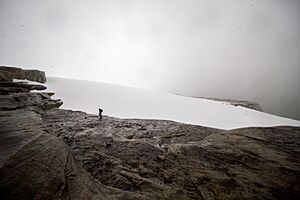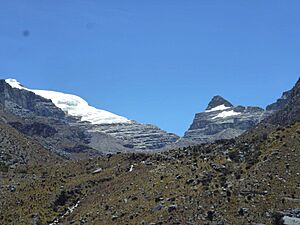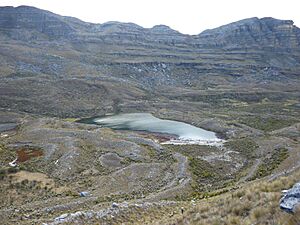Sierra Nevada del Cocuy facts for kids
Quick facts for kids Parque Natural Sierra Nevada del Cocuy, Chita o Guican |
|
|---|---|
| Sierra Nevada del Cocuy, Chita o Guican National Natural Park | |
|
IUCN Category II (National Park)
|
|

Pan de Azúcar (5120 m) in the Sierra Nevada del Cocuy
|
|
| Lua error in Module:Location_map at line 420: attempt to index field 'wikibase' (a nil value). | |
| Location | Departments of Arauca, Boyacá and Casanare |
| Nearest city | Tame, Arauca, Colombia |
| Area | 3,062 km2 (1,182 sq mi) |
| Established | 1977 |
| Governing body | SINAP |
The Sierra Nevada del Cocuy Chita or Guican National Natural Park is a special place in Colombia. It is also known as Sierra Nevada de Chita or Sierra Nevada de Güicán. This park is a national park with high mountains and icy peaks. It is part of the Eastern Cordillera mountain range in the Andes Mountains.
This park has the largest amount of ice in South America, north of the Equator. Since 1977, this area has been protected. It is important because of its unique high-altitude grasslands called páramos. It also has amazing plants and animals found nowhere else. The park helps migratory animals move safely as the climate changes. You can see 18 ice-covered peaks, icy lakes, and beautiful waterfalls here.
| Top - 0-9 A B C D E F G H I J K L M N O P Q R S T U V W X Y Z |
Discover the Park's Location and Size
The Sierra Nevada del Cocuy is in the Eastern Cordillera of the Colombian Andes. It sits between the areas of Boyacá and Arauca. The official name of the park is Parque Nacional Natural el Cocuy (PNN El Cocuy). This park covers all the icy peaks and some of the páramo areas.
The park is about 3,000 square kilometers (1,158 square miles) in size. Almost half of this area (47%) is covered by páramo ecosystems. The Sierra Nevada del Cocuy has Colombia's largest ice mass. The melting ice from these glaciers feeds important rivers. These rivers include the Arauca, Casanare, and Chicamocha. They flow into the Magdalena and Orinoco basins. Many people in Colombia and Venezuela use this water for farming and daily life.
High Peaks of the Sierra Nevada del Cocuy
The park is home to many tall mountains. Several of these peaks have snow on them all year round. Some of the highest peaks include:
- Pan de Azúcar (5,120 meters or 16,798 feet)
- el Púlpito del Diablo (5,100 meters or 16,732 feet)
- Cóncavo (5,200 meters or 17,060 feet)
- Concavito (5,100 meters or 16,732 feet)
- San Pablines South (5,180 meters or 16,995 feet)
- San Pablines North (5,200 meters or 17,060 feet)
- Ritacuba Blanco (5,330 meters or 17,487 feet)
- Ritacuba Negro (5,300 meters or 17,388 feet)
- Sirara (5,200 meters or 17,060 feet)
Other peaks like Diamante, Toti, Portales, Picacho, Puntiagudo, el Castillo, and an unnamed peak are also very high.
Explore the Park's Geology
The Sierra Nevada del Cocuy region has the highest parts of the Eastern Cordillera. These mountains formed over millions of years. They were once a basin that collected sediments. Later, the land pushed up, creating the tall mountains we see today. This uplift has been happening for a long time.
The rocks in the Sierra Nevada del Cocuy are mostly sedimentary rocks. These rocks formed from sand and mud deposited in ancient oceans or coastal areas. They have been lifted about 5 kilometers (3 miles) since they were first laid down. Much of this uplift happened more recently, starting around 7 million years ago.
Discover the Park's Biology and Ecology
Most of the area around the icy peaks is covered by páramo ecosystems. These are high mountain areas, usually between 3,000 and 4,800 meters (9,800 and 15,700 feet) above sea level. Páramos are special tundra ecosystems found only in tropical South America. They are also found in Costa Rica and Panamá.
Páramos are very important for nature. They have many unique plants and animals. They also help regulate water, store carbon, and reduce the effects of climate change. Because páramos are like "islands" on different mountain ranges, they have developed unique plants and animals over millions of years.
Plants and Animals of the Páramo
One of the most famous plants in the Sierra Nevada del Cocuy páramo is the yellow-flowered Frailejón (Espeletia lopezii). It grows widely below the ice line. Many other plant families, like Compositae and Rosaceae, also thrive here.
The park is home to many animals, including:
- Tapirs
- Brown bears
- Andean condors
- Eagles
- Páramo deer
- The famous Spectacled Bear (also called Andean Bear)
These animals are still seen in the park today.
Protecting the Páramo Ecosystem
Even though páramos are unique and vital for people, they have faced environmental challenges. People have lived in this region for a long time, including the U’wa indigenous groups. Over time, farming has expanded, changing the landscape. These changes make it harder for the páramo to store water. They also affect the delicate plant and animal communities.
New farming methods and the introduction of non-native plants and animals have caused problems. About 32% of the plant species in the Sierra are not native. As the climate gets warmer, these issues can get worse. Unwise land use, combined with climate change, harms important native plants, especially those used for medicine.
Understand the Park's Glacial History
The Sierra Nevada del Cocuy has likely had glaciers for about 3 million years. Studies show that the climate in this region has changed a lot over the last 50,000 years. Glaciers in Cocuy grew before the largest global ice period about 20,000 years ago.
Glacial Retreat and Climate Change
Around 1850, during a period called the Little Ice Age, the glaciers were at their lowest point. Since then, the glaciers have been shrinking very quickly. They have been losing about 1 square kilometer (0.4 square miles) of ice each year. Scientists have seen this rapid melting using satellite photos and measurements.
The Sierra Nevada del Cocuy glaciers were once one large ice body. However, by 2006, they had lost about 35-45% of their ice in just 15 years. Scientists predict that all the ice in this region could be gone by 2040. Some studies even suggest it could happen as early as 2025. These tropical glaciers are very sensitive to global warming. The warming rate is higher in high-altitude areas, sometimes double the rate at sea level.
Native Peoples of the Park
The U'wa (also called Tunebos) are the native people of this region. Their reservation overlaps with the park area. This means that part of the park is used by them for farming, grazing animals, hunting, and fishing.
Between 1969 and 1977, the Colombian government encouraged people from other parts of Colombia to move into the park area. This led to the U'wa people losing some of their land. It also created other settlements within the park.
Climate in the Sierra Nevada del Cocuy
The Sierra Nevada del Cocuy has a cold alpine tundra climate. It gets moderate to little rainfall and sometimes snow throughout the year. The weather data below is for Alto la Cueva. Other places in the park might have different temperatures, and some areas are covered in snow all year.
| Climate data for Alto la Cueva | |||||||||||||
|---|---|---|---|---|---|---|---|---|---|---|---|---|---|
| Month | Jan | Feb | Mar | Apr | May | Jun | Jul | Aug | Sep | Oct | Nov | Dec | Year |
| Mean daily maximum °C (°F) | 13.2 (55.8) |
12.4 (54.3) |
12.2 (54.0) |
11.4 (52.5) |
11.1 (52.0) |
11.2 (52.2) |
11.2 (52.2) |
11.3 (52.3) |
11.3 (52.3) |
11.2 (52.2) |
11.4 (52.5) |
12.0 (53.6) |
11.7 (53.0) |
| Daily mean °C (°F) | 7.2 (45.0) |
6.9 (44.4) |
7.0 (44.6) |
6.8 (44.2) |
6.7 (44.1) |
6.7 (44.1) |
6.6 (43.9) |
6.6 (43.9) |
6.6 (43.9) |
6.5 (43.7) |
6.6 (43.9) |
6.9 (44.4) |
6.8 (44.2) |
| Mean daily minimum °C (°F) | −0.5 (31.1) |
−0.1 (31.8) |
0.8 (33.4) |
1.3 (34.3) |
1.7 (35.1) |
1.7 (35.1) |
1.4 (34.5) |
1.4 (34.5) |
1.4 (34.5) |
1.4 (34.5) |
1.3 (34.3) |
0.6 (33.1) |
1.0 (33.9) |
| Average rainfall mm (inches) | 23.4 (0.92) |
38.4 (1.51) |
64.6 (2.54) |
120.7 (4.75) |
138.4 (5.45) |
98.4 (3.87) |
82.5 (3.25) |
90.0 (3.54) |
103.8 (4.09) |
128.1 (5.04) |
99.6 (3.92) |
53.7 (2.11) |
1,041.6 (40.99) |
| Average rainy days | 6 | 9 | 11 | 18 | 23 | 21 | 20 | 20 | 20 | 21 | 18 | 13 | 200 |
| Average relative humidity (%) | 84 | 84 | 84 | 85 | 85 | 85 | 86 | 86 | 86 | 86 | 86 | 85 | 85 |
| Mean monthly sunshine hours | 220.1 | 183.5 | 164.3 | 108.0 | 96.1 | 117.0 | 145.7 | 139.5 | 111.0 | 105.4 | 129.0 | 186.0 | 1,705.6 |
| Mean daily sunshine hours | 7.1 | 6.5 | 5.3 | 3.6 | 3.1 | 3.9 | 4.7 | 4.5 | 3.7 | 3.4 | 4.3 | 6.0 | 4.7 |
| Source: IDEAM | |||||||||||||
See also
 In Spanish: Parque nacional natural El Cocuy para niños
In Spanish: Parque nacional natural El Cocuy para niños




